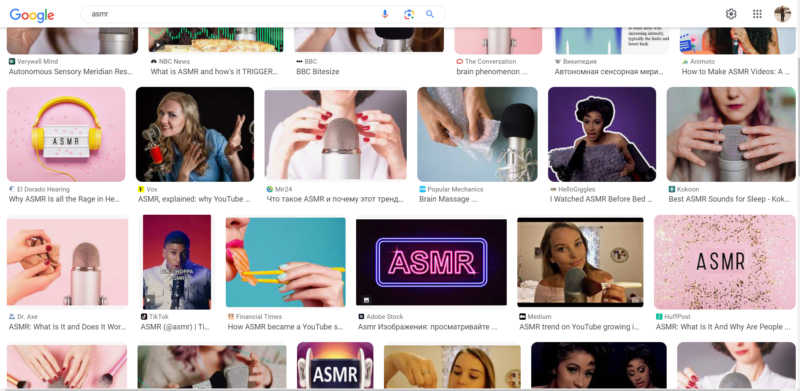Admit that you often spend hours after hours watching literally nothing on YouTube. You scroll videos where hands of people you don’t know do some stereotypical, repetitive things like pressing buttons, applying stickers, doing makeup, sharpen pencils, cutting hair, spitting on the mike, eating, etc. Sounds seem to be an important part of it. It is called ASMR (autonomous sensory meridian response).
According to the Wikipedia, is a “subjective experience of “low-grade euphoria” characterized by a combination of positive feelings and a distinct static-like tingling sensation on the skin. It is most commonly triggered by specific auditory or visual stimuli, and less commonly by intentional attention control”. So, it is officially supposed to make you happy. Thanks to numerous online ASMR providers, you are supposed to easily go into a mindless state of relaxation, into a digital Nirvana.
But is it that simple and innocuous as a mere anaesthesia from life? Nope, it is not, if you have a closer look. Note that below I will mention my experience with Russian-language channels, but I’m certain it is a global thing. If you are a Russian-speaker yourself, just go to YouTube and listen to my new audio in Russian on the same subject. And subscribe of course.
First and foremost, whenever you watch some content, ask yourself why you watch it and why it is shown to you. There is always a reason to everything. I assume that probably 10% of channels having ASMR videos on them are what they seem to be and their goal is modest income from jaded scrollers and surfers. Some use ASMR to support their main subject. For example, an artist may throw in a short pencil-sharpening clip or an art supplies unpacking video to keep up with the trend and to get more attention with the #ASMR tag. The rest of your daily relaxation comes with a hidden message in it.
It may start just as videos with repetitive images and sounds. Nice landscapes and high-pitched music that seems to have come from space. Then there is a moment when words come into picture. They may seem totally meaningless. For example, there is a Russian-language channel with repetitive videos of cooking (doesn’t even look like a coherent recipe) where a female voice just tells us about her day: her shopping experience or arguments with neighbors, etc. Why? What for? I’m sure that deep analysis of those texts would be revealing.
Another channel is more obvious. There is a girl who applies makeup in front of the camera. Each of her shorts has the same sequence of motions. There is always the same setting. She speaks in a monotonous voice, her intonations are wierd, not Slavic I’d say, though she is definitely a Russian speaker. She speaks about psychology. It’s simple and popular stuff, 50-60% of what she says is banal, reasonable or acceptable. She does seem to be moderately feminist and her target audience are definitely girls (my fellow women, why 99% of BS is targeted at us? Let’s be smarter, stronger and resist it! eh?) The rest of her content is sheer liberal agenda though, in particular, pro-LGBTQ+ stuff although she denies it. Where she came from? Who is she? Is is she an actual shrink or an amateur? Nothing can be learned from the channel description. The name seems to be a nickname. She peppers her speeches with tons of unnecessary English words which also seem to be anchors.
In this case I see how ASMR works hand in hand with the 60/40 approach. 60/40 means that a media (channel, blogger, etc.) demonstrates open loyalty to a specific idea/side/principle. It can be Russia, communism, common sense, science, equal rights, whatever. Or the media/blogger is positioned as professional in something (e.g. psychology). It is needed to gain some initial trusting audience. But a cautious consumer will notice that 60% of the content will speak in support of the chosen topic/opinion/side, while the rest of it will push contradicting ideas. In modern politics it would be a pro-Russia channel throwing in some pro-Ukraine content once in a while. Probably it will start as 80/20 going to 20/80 (remember the boiling frog?). But it is a broader concept. In my example there is a girl who acts as a bearer of common-sense and life experience while pushing some ultra-liberal values.
Apart from relying on the 60/40 principle, it also litters your brain with ideas through the use of ASMR and simple NLP (repetitive videos and verbal anchors). It will not surprise me if after watching 20 videos like that one starts repeating her makeup sequence automatically. After 50 videos you become a fan sharing all her ideas. After 100 you lose your precious critical thinking. After 110 you probably go and shoot people in the street.
I’m not even exaggerating. Human brain is a wierd thing. To not get caught, be vigilant of what you put into your head not just your mouth. Brain poisoning is worse than food poisoning. Keep watching whether your favorite relax channel is changing. Is it still just music and landscapes or there are some words there too? Which words are these? What is the idea? The goal?
I don’t want to sound like a scared conspiracy theory lover, but some things are just too obvious and it’s logical to be careful.



Although copying has a bad name in the modern era where everybody extols “originality”, fact remains that copying (mimesis) is how mammals learn (emotions, survival, interaction, everything). And if you can copy somebody playing Bach or painting a van Gogh, you are well on your way to mastering something. Modern education tries to annihilate this (‘rote’ learning) as a tool to learn, with disastrous result. In terms of behavior, if you place a misbehaving boy in a setting (family) with boys his age who do behave, you will see a turn around within two days as he adapts.
Copying works largely unconsciously. For instance, when I lived in Chicago I was deliberately trying not to assimilate the mid-Western drawl, but if you have the aptitude to shift accents, it will happen willy nilly that you adopt accents of the people or milieu around you. So I will assume that ASMR is slowly assimilating you to certain pockets of society, even if it is largely an osmotic process.
There is another more innocent side to this: The human eye and ear is drawn to motion and sound. Back in the day when you had to defragment your HardDisk from time to time, if you had guests and the computer had an illustrative animation of what it was doing (hours long), people’s eye would be drawn to the spectacle, even though it is uninteresting and uninformative. Children are also automatically drawn in to TV. That is why children’s programs never have a moment of silence and still iamges — one second of rest is enough to break the spell and maybe they will move on to something else. It works just like with a cat.
The worst part of this always on tap distraction is that boredom is a very creative force, forcing children and adults to try something different and novel.
On the other side, human concentration is short. If you are studying/learning something, you need to focus a few seconds at a time, look away, restart your concentration, taking a bigger break every 5 mins and an even bigger one every hour or so. You may notice if you concentrate on a problem too much, you get stuck, and going for a bicycle ride or a walk often brings you new angles or experiments to try and solve it. You need to sink into good rhythms on this front, and kids who do not have learning difficulties, not matter how much time they dedicate to learning. If you are trying to study a passage of music, repeating it too many times is contra-productive … you need to drop it, play other stuff, and come back to it. Many small sessions are superior to long sessions.
Without screen devices, people also do much the same thing. Kids look out the window at school, watch the birds or the grounds keeper. People like to sit around a fire and watch the flames, or sit by a brook and listen and follow the endless changing cascade of water of a water falls. However, such distraction is natural, restful, and not laden with “perspectives” and unconscious programming or ideology.
Anyways, there are a lot of facets to this kind of behaviour.
It’s not my point. Children learn by copying and it is good. But indoctrination is not good, especially the one you didn’t ask for. Also, there are many reputable sources of educational content that are supported by schools or prominent individuals you feel you can trust. They don’t hide or feed you with wierd stuff.
My point was that the Internet is full of more or less unanimous sources that use the weaker side of our strengths to give us ideas we don’t need.
Good thing I always had a viscerally negative reaction to ASMR things. Whenever I hear it, my first and only instinctive response is to want to throw a punch through the offending device at whoever is making that infernal insidious noise.
You’re absolutely on the money in terms of the main thrust of it. People the world over are extremely susceptible to being manipulated by what they seek out for entertainment (yes, even porn has politics snuck into it, and more often than people may think) because they tend to just turn their brains off and take it all in – it’s just soft mindless fun, what harm could it be? And that’s why all those messages stuck into one’s favourite TV show, musician’s output, Youtuber and online streamer content and whatnot are so very important, and so very effective. ASMR is absolutely no different.
Just don’t bother with YouTube.